

Living Walls is a concept for creating vertical green areas where conventional 'horizontal' areas are restricted....its not new, but it is gaining momentum and could be the 'next big thing'...........
Below: Dr. Howard Lee opens the Living Walls Conference
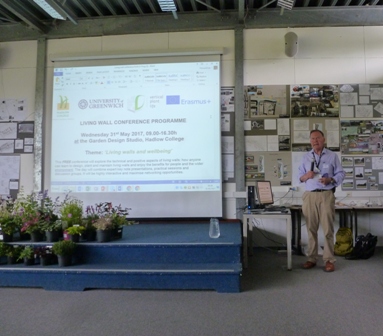 On Wednesday, The English Apple Man attended a Living Walls Conference held at Hadlow College. Organised by Dr.Howard Lee, Lecturer - Sustainable Agriculture, Agroecology.
On Wednesday, The English Apple Man attended a Living Walls Conference held at Hadlow College. Organised by Dr.Howard Lee, Lecturer - Sustainable Agriculture, Agroecology.
The English Apple Man has got to know Howard well in the last few years; we both take part in Hadlow College Press Officer Pat Crawford's Rural Focus Group and anytime spent with Howard is 'a learning curve'..........
The Conference Theme: 'Living walls and wellbeing'
This was a FREE conference exploring the technical and positive aspects of living walls: the agenda demonstrated how anyone can learn to design, plant and maintain living walls and enjoy the benefits for people and the wider environment. The day combined expert key note presentations, practical sessions and discussion groups, intended to be highly interactive and maximising networking opportunities.
Howard Lee introduce the speakers and set the scene for the Conference: The morning session would involve presentations covering the concept, design, installation, environmental and health benefits. After lunch practical demonstration and discussion using the Hadlow College demonstration Living Walls (one outside and one inside)
Below: 80 delegates attended the Living Walls Conference
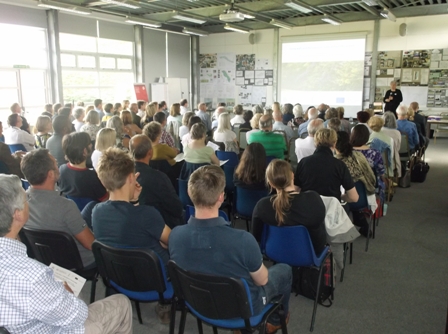 80 people attended the Living Walls Conference organised by Howard; a mixture of Students (obviously) - Landscape Gardeners - Garden Designers - Architects and those with a desire to find out what 'Living Walls' have to offer the general public..........
80 people attended the Living Walls Conference organised by Howard; a mixture of Students (obviously) - Landscape Gardeners - Garden Designers - Architects and those with a desire to find out what 'Living Walls' have to offer the general public..........
 The inventor credited as the creator of Green Walls/Living Walls was French Botanist Patrick Blanc
The inventor credited as the creator of Green Walls/Living Walls was French Botanist Patrick Blanc
Patrick Blanc is a French botanist and designer who has been on a quest to create green walls across the planet with his plant-based creations for the last 25 years.
The concept has more recently been accepted as the invention of Professor Stanley Hart White at the University of Illinois Urbana-Champaign in 1938. Professor White patented the first known Vertical Garden, or "Vegetation-Bearing Architectonic Structure and System", as a treatise on modern garden design, predating Patrick Blancs contemporary patents by nearly 50 years.
Although Blanc did not invent the vertical garden, he is responsible for modernizing and popularizing the garden type.
In 2013 Blanc changed the appearance of an uninteresting concrete wall in Paris into a green Living Wall, transforming the area into one of beauty........The Oasis of Aboukir is a 25-metre-high green wall by botanist and researcher Patrick Blanc, which covers a building facade in the second arrondissement of the city.
The wall features plants from 237 different species and appears to grow up the facade in diagonal waves. It was planted in the spring and covers the previously raw concrete facade on the corner of Aboukir Street and Petits Carreaux street.
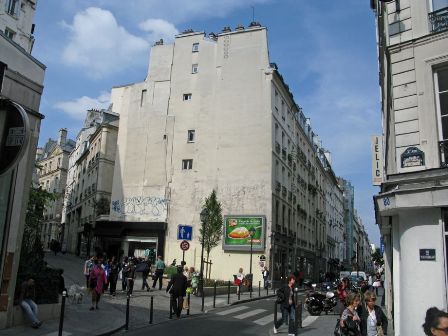
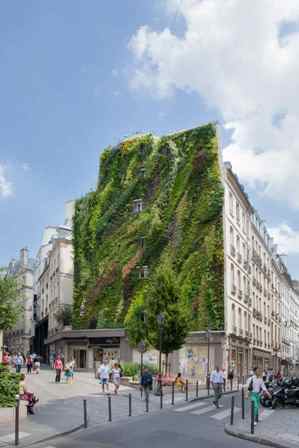
Below: Living Walls offer many services to Urban eco systems....
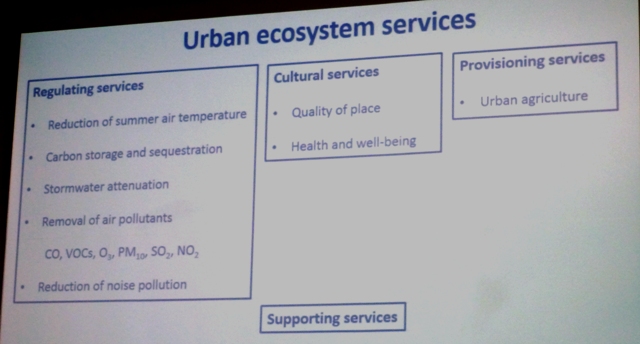 Dr Sarah Milliken - Research Assistant in the School of Architecture, Computing and Humanities at the University of Greenwich:
Dr Sarah Milliken - Research Assistant in the School of Architecture, Computing and Humanities at the University of Greenwich:
Sarah presented 'Living Walls and the ERASMUS+ Vertical Plant Life' project.
Pictures of innovative Living Walls adorning Supermarket walls, public areas, inside offices and community buildings......the value of Living Walls as a mechanism for dealing with air pollution.....the ability of plants to breath in C02 and expel Oxygen has been central to our understanding of the importance of forests across our planet. The identity of more subtle gasses given off by everyday items; e.g. paper, furnishings, carpets etc. and the ability of specific plants in absorbing and cleansing this contaminated air is possibly the 'seed ' for a great leap forward in dealing with air pollution.........
Click to view ERASMUS+ Vertical Plant Life 40 hour course for Further Education level horticulture students.
Below: left; Dr. Sarah Milliken and right; Dr. Pam Worrall and Will Hughes
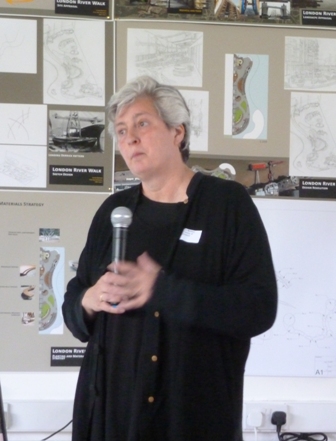
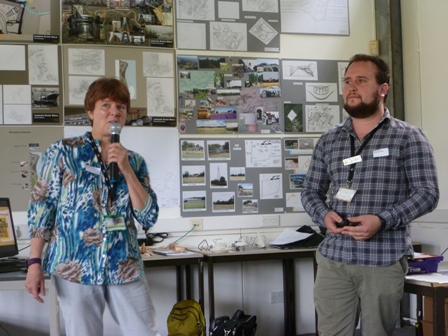
Dr Pam Worrall and Will Hughes - Presented Living Walls at Hadlow College.
Living Walls are thought to provide a habitat for a variety of insects and invertebrates, thus increasing local biodiversity, whilst also bringing an aesthetically pleasing aspect to the facades of areas undergoing construction.
Pam and Will shared their research into the Biodiversity and wildlife value of Living Walls based on their experience with the Hadlow Living Wall.........among their observations, they found birds of various species visited the Living Wall and some showed signs of seeking nesting places. They had a natural tendency to populate the higher aspect of the wall.
Dr Howard Lee
Living Walls at Hadlow College: 'Benefits for People'
Howard Lee highlighted the Health & wellbeing benefits of Living Walls
The World Health Organization defines human health as: "a state of complete physical, mental and social well-being and not merely the absence of disease or infirmity." - Wellbeing: "The state of being comfortable, healthy, or happy" (Oxford Dictionary).
Howard identified the link between physical well-being and living walls: "Green exercise - working on the walls, cycling/walking to get there. Medical evidence; - Food - growing and eating; - Biodiversity; - Economics - enhanced value; - Outdoors & Indoors: walls can filter the air, reduce noise, improve local atmosphere.
Shelley Mosco University of Greenwich - Planting designs for Living Walls
Shelley has been designing Living Walls since 2005 and explained the critical criteria in LW design. Back in the early days, Shelley told the Conference Delegates she was designing for millionaires with desire to create 'living works of art' - often re-creating an 'old master' picture as the model for a Living Wall.
Today designs are more likely to be for commercial buildings, community areas et al.
Niall McEvoy Scotscape Living Walls - Building and maintaining Living Walls
Below: left; Shelley Mosco and right; Niall McEvoy
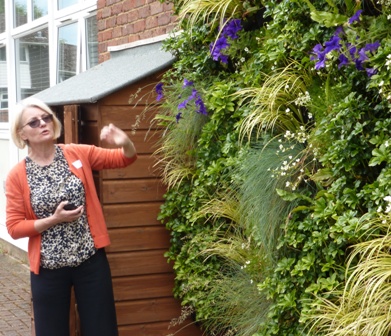
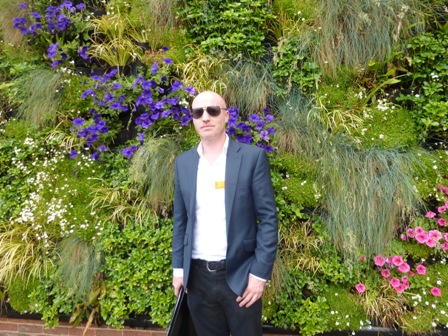
Below: pouches on 1 metre square panels combine to create Living Walls of any size
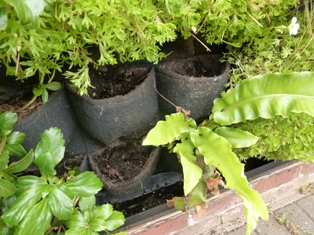 Niall McEvoy - Business Development Manager of Scotscape a leading supplier of Living Walls (Green Walls), Green Roofs, Landscape Construction Services, Landscape Maintenance and Irrigation.
Niall McEvoy - Business Development Manager of Scotscape a leading supplier of Living Walls (Green Walls), Green Roofs, Landscape Construction Services, Landscape Maintenance and Irrigation.
Scotscape has 30 years sustained growth in the commercial and private landscape Industry, employing over 60 staff at their head office and nursery in Surrey.
Scotscape has installed Living Walls, in London and the UK, and also in Holland, Belgium, Spain and the Middle East.
Niall explained how the Living Wall is constructed: with 1 metre panels made of a hard backing material, a fibre mat (made from recycled material) and front with lines of pouches. The wall is then fed by an irrigation system delivering water and nutrients in timed application periods......
Click on Scotscape Living Walls for detailed information about the company's installation and maintenance of Living Walls.
Below: left; Hadlows Living Wall and right; Niall McEvoy explaining the mechanics of installation and maintenance of Living Walls
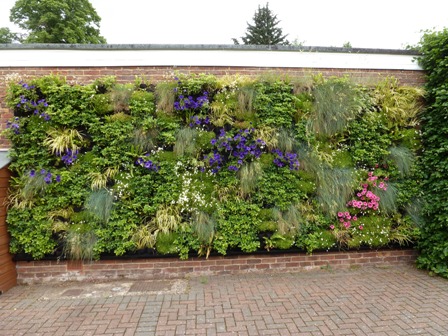

Below: left; the Hadlow Living Wall inside and right; the lighting units which operate circa 12 hours on and 12 hours off
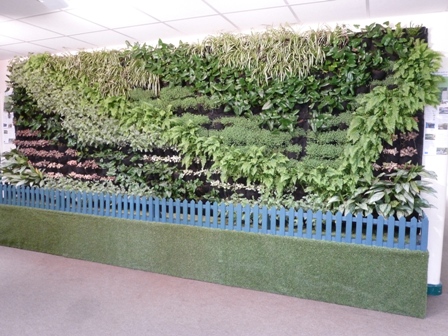
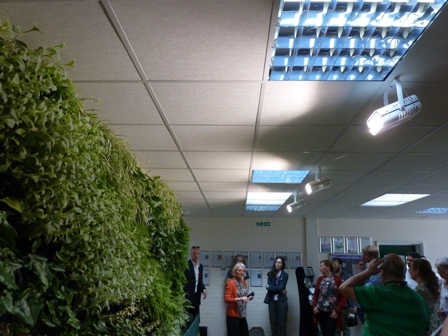
The English Apple Man comments........
There is so much more that can be said about Living Walls; Edible Walls are part of the equation, mixed plant life, edible and non edible, bird boxes, bee houses, all are part of the design mix.
In my working life as a fruit grower and later in a technical role, the ability of the apple trees (or any other tree) on a farm to absorb 20 x more C02 than produced by activity (tractors etc.) and expel Oxygen was a strong advocate for fruit farming practices.
During the Living Walls Conference 'informal discussions' (networking) the Living wall inside an office building was mentioned on several occasions as an 'effective' air cleanser - situated near the toilets, many staff have observed how much fresher the air seems in the area where the Living Wall is situated.........
Below an example of the importance of plants in overcoming air pollution........
"Last month, (late 2016) an 80m2 "living wall" was unveiled at a Mayfair development site owned by property group Grosvenor. The wall, which consists of wild grass, flowers and fruit embedded into a scaffold, is hoped to help curb emissions by as much as 20%.
However, with a problem as complex and far-reaching as air pollution, a flexible approach is key to solving the challenges it holds. For that reason, much has been made of the huge potential of so-called living walls, which have the ability to actually take out some of the pollution that is already lurking in our atmosphere (rather than just limiting future emissions).
This works via a process of absorption. Harmful contaminants such as particulate matter 10 (PM10) and nitrogen dioxide (NO2) stick to the leaves of vegetation, thus removing them from the atmosphere and cleaning up the environment. With this huge benefit in mind, Grosvenor has included the addition of living walls in its ambitious plans to cut emissions from all of its buildings by 50% before 2030
Much speculation, but very little formal evaluation of Living Walls to date: but a thorough case study in Spain has started the evaluation process.........
Below: an extract Media and social impact valuation of a living wall: The case study of the Sagrado Corazon hospital in Seville (Spain)
Vertical greening systems have increased in popularity during the recent years due to their experience adding ecological and aesthetic value for current clients. The use of living walls is in line with a service sector focusing on environmental consciousness. Still, scientific evidence is lacking regarding the multiple benefits of LW. There is also a lingering fear of high installation and maintenance costs.
Urban greening systems, and in particular LWs, have many benefits, some of which are difficult to measure. Exposing and quantifying those benefits can play an important role in order to incentivise their use.
Please note: On Monday 12th June - Food, Farming & Sustainability - a one day conference will be held at Bore Place, Chiddingstone, Edenbridge Kent. The event runs from 9.30am - 5.30pm and costs £20 inclusive of lunch and a tour of Bore Place.
To book a place visit: Bore Place or email: Howard Porter
That is all for this week....
Take care
The English Apple Man